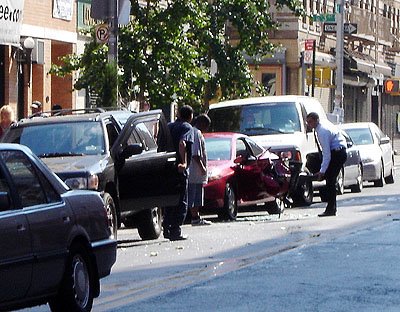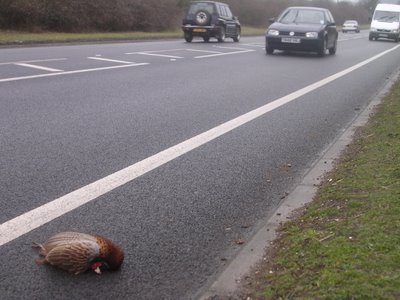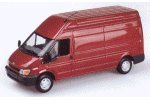The Driving Standards Agency (DSA) are currently conducting a Highway Code Consultation, for proposed updates and changes which we will all have to follow. Below I have analysed the rules particularly relevent to cycling.
Get your opinion in to the DSA now! - consultation ends 10th May '06.
Whatever is documented in the Highway Code is absolute black & white. Disengage your reasonable braincells for a minute, because the Highway Code will be interpreted literally, from any number of different viewpoints.
Be it a copper with a headache and a book-full of technical infringements you may have just commited unawares. Or a lawyer defending the car driver who knocked you off your bike, and is seeking to highlight any technical rules you may have broken, in order to get the car driver off the hook.
My aim here, is to help make the Highway Code as cohesively and realistically workable as possible.
CYCLING SPECIFIC
RULE 57 - (Agree) Have lights front & back, flashing lights permitted. Hooray! Common Sense prevails.
RULE 58 - (Disagree) "Use cycle facilities where they are provided." No. Cycling exactly within designated cycle facilities it is often much more dangerous than riding realistically, using roadsense to decide the safest option.
For example, by riding in a cycle lane situated next to parked cars, the Highway Code is instructing you to ride IN the door zone, how dangerous is that!
RULE 59 - (Disagree) "When using segregated (cycles / pedestrian) tracks you MUST keep to the side intended for cyclists as the pedestrian side remains a pavement or footpath."
No. Pedestrians are forever wandering obliviously all over the cycle side of the "segregated" paths. I have no problem just riding around them, but don't make me a law breaking criminal because I had to pass the pedestrian on the side with legal pavement status. "MUST" should be changed to "should".
RULE 60 - (Disagree) "Keep within cycle lanes wherever possible." No. I will be out of the cycle lane for a variety of reasons when legally I could be kerb-hugging in a cycle lane.
E.g. I will move to the centre of a lane to discourage dangerous overtakes, I will regularly leave the cycle lane to overtake cars parked in the cycle lane. I will plan ahead and join the turn-right lane, if I want to turn right, rather than undertake on the left and scurry across the front of impatient traffic at a Advanced Stop Line. Omit: "Keep within the lane wherever possible."
RULE 61 - (Disagree) "You MUST NOT cycle on a pavement." Sure, in a busy town centre this is obvious, pavement riding is statistically more dangerous anyway. But say you are taking your 5 year old daughter out for a ride on her trike - the Highway Code says you should be on the road.
I know of many footpaths which previously were legally forbidden to cyclists, and a year later had some nice blue signs installed and became cycle paths. So I'm not going to wait for permission to take a safer route today. Also see RULE 59 comments - overtaking pedestrians in a segregated cycle path, requires you to use the footpath, which has legal pavement status. So to say "MUST NOT" is impractical. It should be a more flexible "Should not", and stress the main users of pavements, does not include cyclists.
RULE 62 - (Agree) "Most bus lanes may be used by cyclists" A cheap policy decision which in one hit successfully allows decent space for cyclists to overtake each other, and be allowed a safe gap when being overtaken by cars.
RULE 63 - (Agree - except:) "Not carry anything which will affect your balance."
Lawyers would have a field day here! OK, common sense check please: - If I carry ANYTHING , it WILL affect my balance & the handling characteristics of my bicycle. Fact. (panniers, saddle bag, trailer, even a ruck-sack.)
I guess the DSA are trying to get at: "don't cycle and carry a ladder under your arm, or something similarly extra-ordinarily. Omit this impractical line totally please.
RULE 64 - (Agree) But note how the good safe riding advice in this rule, is contradicted quite widely by the actual real-life cycle facilities.
E.g. Road narrowings with cycle markings which DIRECT you to swerve in to the flow of traffic. E.g. RULE 64 says "Leave plenty of room when passing parked vehicles" (avoid the door zone). Yet conflictingly, RULE 58 dictates you should ride in facilities including some badly designed cycle lanes, which are situated in the door zone next to parked cars!
RULE 65 - (Agree) Cyclists, don't be stupid, basically.
RULE 66 - (Agree) "You MUST obey all traffic signs and traffic light signals."
RULE 67 - (Agree) Park your bike sensibly.
RULE 68 - (Disagree) "You MUST NOT cross the stop line when the traffic lights are red."
It is clear that cyclists stopping ahead of vehicles at red traffic lights in full view of the driver behind, is much safer than being squashed along side vehicles. Hence the Advance Stop Line benefits.
However, when (and it OFTEN happens) vehicles stop in the big green box with a cycle logo in it (Duh!). Then I (Cycling) will retain my safe position ahead of the vehicles, even if this means stopping ahead of the stop line, as a consequence of "Mr Dumb" stopping IN (instead of behind) the Advanced Stop Line. The point is, I won't go through the red light, but I will cross the stop line if that guarentees I can be seen clearly by drivers when setting off. Ammend to: "Do not pass traffic lights when red."
RULES 69 to 73 (Agree) Various.
RULE 74 - (Disagree) "You may feel safer either keeping to the left on the roundabout."
Counter-productive, irrisponsible & dangerous advice. To be fair, the Highway Code does then point out the high risk nature of Rule 74's advice:
- Drivers look for traffic in the centre of the road, not in the gutter, drivers often won't see you, and will pull out in your path.
- Drivers may wrongly assume that any cyclist on the left, will automatically be taking the next exit, when the cyclist continues on the roundabout and the driver exits the roundabout, an obvious collision can occur here.
- Vehicles entering & leaving the roundabout will do so as normal, often not taking in to account a cyclist riding such a timid road positioning (in the gutter).
Better advice would be to ride a roundabout as any other vehicle does. If the traffic density is prohibitively high, then segregated cycle facilities and crossings should be provided.
RULE 75 - (Agree) "Give plenty of room to long vehicles on the roundabout."
RULES 76 - 79 (Agree) Crossing the road. But note that in future, if there are adequate cycle routes, the need for cyclists to cross from pavement to pavement should be rare.
CYCLES AND VEHICLES INTERACTIONS
RULE 160 (Expand) - "DO NOT overtake if there is any doubt, or where you cannot see far enough ahead to be sure it is safe. e.g. a corner or bend,a hump bridge, the brow of a hill."
Expand to include: "Do not overtake cyclists where insufficient space makes such a manouvre unsafe: E.g. Road narrowings, pedestrian refuge islands, keep left signs, speed cushions, speed chicanes, central road islands, etc. "
RULE 172 (Expand) - Advanced Stop Lines (ASL): "Motorists, MUST stop at the first white  line reached"
line reached"
This seems to generate confusion for some motorists, who will purposely drive in to the ASL box, designated for cycles, regardless if cyclists are present or not.
Some drivers treat it as "optional" and will park in the ASL box when no cyclists are in front. Which means when cyclists filter to the front of traffic lights, they are presented with no safe ASL box to stop or turn right in.
Any argument that drivers need the box for additional braking is rubbish. Modern brakes halt cars well within the Highway Code's stated stopping distances. Regardless where the stop line is, it is a driver's responsibility to judge on an amber light if it is safe to stop or not, this is a yes or no decision.
See RULE 68 Comments. RULE 172 Needs to be made clearer: i.e. "Motorists MUST NOT stop within the Advanaced Stop Line area designated for Cyclists, at any time."
RULE 176 - (Expand) "Do not overtake just before you turn left"
This direction is frequently disregarded everyday. Causing cyclists to react and avoid collisions arrising from a motorist's erroneous judgement & timing, turning left across cyclists, immediately after just overtaking the cyclist! Perhaps it requires stronger emphasis; replacing "Do not", for MUST NOT "
RULE 205 - (Expand) "Be especially careful when turning or changing direction. Be sure to check mirrors and blind spots."
Agree, but could rephrase to: "Be sure to always check mirrors and blind spots." To convey the importance that purposeful mirror checking, is inherrent in a safe system of driving skills. Not just something drivers have to do on their driving test to impress the examiner.
RULE 233 - (Disagree) On-road vehicle parking - "you MUST ensure you do not hit anyone when you open your door. Check for cyclists or other traffic"
This is one of the biggest & most underated cause of accidents, particularly involving two wheeled transport.
 Read this with a Lawyer's head - If a cyclist rides past and you hit her with your car door, as you open it, the driver is at fault.
Read this with a Lawyer's head - If a cyclist rides past and you hit her with your car door, as you open it, the driver is at fault.
However if the car door is opened first, THEN the cyclist hits the door, is the cyclist at fault? Even if it was 0.1, 0.5, or 1 second before impact?
Or howabout when a car door is opened thoughtlessly, and a cyclist has to take avoiding action, does not HIT the car door, but results in a separate collission, how is culprability tracked back to the originator, who opened the car door?
Realistically, it is the drivers obligation to be certain it is safe to introduce their large metal obstruction in to the traffic flow, responsibly. The wording should be revised to reflect this fact.
Suggested revision: "You MUST wait until there is a safe gap in traffic flow, in which to open your door. You MUST check for cyclists, motorcyclists and pedestrians before opening your door. You MUST NOT cause an obstruction to traffic, by opening your door."
RULE 234 (Ammend) "You MUST NOT stop or park on a cycle track"
Add: "or any cycle lanes." The logic behind no parking in bus lanes, (aside from the fines revenue), is to improve the attractiveness of busses in terms of speed, priority and service.
Cycle lanes deserve the same status from parking abuse. Not only could it be a huge new scope for parking fine revenue income, but cycling deserves to be given the highest status, promoting to potential new riders all the personal health and environmental benefits cycling delivers.
*** END OF ANALYSIS ***
If you agree with the above suggestions, or have other opinions you would like to voice, get in touch with the DSA here, and make your opinion count. I have no problem if you want to cut & paste the above and send it to the DSA, with your own comments on.
Technorati Tags: Highway-Code / Cycling





 1/. Opening your parked car door without fully checking what's coming.
1/. Opening your parked car door without fully checking what's coming.

